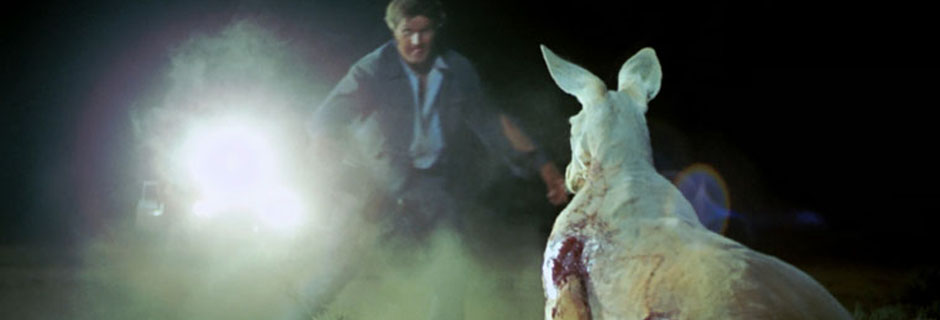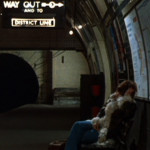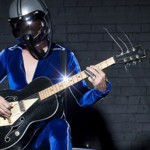HAVE A DRINK, MATE: An interview with TED KOTCHEFF
HAVE A DRINK, MATE: The ‘Aggressive Hospitality’ of Ted Kotcheff’s Wake in Fright
Kier-La Janisse
——————-
Fantasia’s restrospective screenings are often among my favourites, and tonight’s screening of Ted Kotcheff’s rarely-seen Australian proto-horror Wake in Fright – a newly restored 35mm print – is going to be a bloody blitzkrieg on the big screen. This outback misadventure isn’t a typical horror film perse, but it has been credited as the first inkling of Antipodean cinematic horror that would prove an undeniable influence on the late 70s/early 80s Oz-ploitation boom.
Gary Bond stars as a schoolteacher stationed in a desolate outback town. As the Christmas holiday approaches, his dreams of a surfing vacation back in Sydney are disrupted when he gets stranded in the small, alcohol-infused mining community of Bundanyabba, and reluctantly falls in with the violent local yahoos.
It may seem surprising that Ted Kotcheff – a Canadian director who was most known at the time for the sequel to Laurence Harvey staple A Room at the Top and celebrated TV-play Edna, The Inebriate Woman (he would go on to direct ‘Nam flashback actioner First Blood and necro-comedy Weekend at Bernie’s among other things) – would turn in what many Australians consider to be the most realistic portrayal of outback aggression to make it to the screen. The film was nominated for the Palme D’or at the Cannes Film Festival in 1971, a decade after the debut of the Kenneth Cook novel it is based on, but despite the accolades – tempered by criticism at the lengthy scenes of a controversial kangaroo hunt (footage of a licensed hunt – it was not filmed specifically for the movie) – the film was considered lost for many years due to its unavailability on home video and scarce broadcast screenings. Co-starring Donald Pleasance and Aussie screen giant Jack Thompson (the latter just on the verge of stardom), Wake in Fright is the Iron John mentality gone horribly wrong.
——————
So how did a Canadian end up making a film in the Australian outback?
As a Canadian, when I started directing, I had been directing in Canadian broadcasting – television – since 1955. I was 24 at the time. So I directed television for a few years and then I wanted to direct theatre and films. In Canada in 1955 there was precious little theatre, monopolized mostly by British directors, and no films whatsoever. No film industry. So if you wanted to be a film director, you had to go abroad – you had to go to the United States or England. And I decided to go to England because I wasn’t sure whether I wanted to be a film director or a stage director, and in London you had the possibility of doing both. So and I did that, and in the 60s I did 7 plays in the theatre and I did my first three films. The third film, called Two Gentlemen Sharing, was about the racial situation in London in the 60s. And the man who wrote it, a Jamaican writer, great writer [Evan Jones]– he wrote most of Joe Losey’s films – we became fast friends. And a year later, ‘68, ‘69, he said, “You know, Ted, I’ve just been hired to adapt a book, an Australian book called Wake in Fright. And it’s right up your alley, you’d love this book. It’s like ‘Lost Weekend’ in the outback. So if you like it we can go together to see the people who are financing it.” And I read it and loved it – he knew me very well. So we went to the company, an American company called Group W Films, an offshoot of the Westinghouse, and they hired me to direct it.
So I went to Australia and I was a bit trepidatious about it, because I thought what do I know about life in the outback in Australia? But when I got there it was not that different from life in Northern Canada that I had experienced. It was the same vast, open spaces that don’t liberate you, but entrap you, it’s claustrophobic, it imprisons you. And the people had the same kind of male ethos – women hardly existed in that world. It was interesting, in Broken Hill [the town where the film was shot], the suicide rate was 5 times the national average in Australia, which is very high to begin with, and most of them were women.
Because women were excluded; there was nothing out there except the desert. And whatever little there was, women were excluded from – they couldn’t go into the pubs, couldn’t go into the clubs, they stayed at home while their husbands and boyfriends were out drinking and fighting and shooting kangaroos, and so they stayed home and one night they would put their heads in the oven. Not that the same thing applied to Northern Canada, but it was the same kind of male ethos, so I thought “Ah, I understand these people very well,” because I’ve experienced something very similar.
The kangaroo hunt – this is something that was happening already and you were just able to go film it?
What happened was – this was a big problem for me. I remember seeing a French film once back in the 1940s, and in order to show man’s inhumanity to man and to animals, there’s a scene where these war veterans from WWI pour gasoline over a dog and ignite it. And you know they did it for real. They incinerated the dog for the sake of showing how cruel human beings can be. And I though wait a minute, you’ve committed the ultimate cruelty – you did it for a film! To do it for a film was, for me, unforgiveable. So I was faced with a real moral dilemma on how to shoot this kangaroo hunt.
Because it was presumably a centerpiece in the book?
Yes. So while I was pondering this dilemma, one of the Australians said to me, “Well you know Ted, they shoot kangaroos by the hundreds every night. They do it commercially. The carcasses of the kangaroo meat , they slaughter them for the American pet food industry.” I said, you mean all those Americans are giving all their cats and dogs kangaroo meat? So much for animal lovers, right?
So the solution was to go out with them and just photograph what they were doing every night anyway. So I put a camera on the back of their truck, and they hunt exactly like hunters in Canada do with deer – they have a spotlight, and their windshield was retractable, they never even left the truck – and when they see a kangaroo, they turn on the light and the kangaroo stands there, hypnotized. They would rest their guns on the dashboard and they would shoot through the windshield. And I did nothing but put a camera on the truck.
Were you there with them?
Oh yeah, I photographed it. With an operator, just two of us went out with them. And one of the hunters asked me “How would you like us to shoot them? I can shoot them in the heart, the brain or the kidneys.” I said well what’s the difference? And he said “Well, if you shoot ‘em in the kidneys they drop dead just like that. If you shoot em in the brain they do one enormous incredible leap into the air and then they die. If you shoot m in the heart, they do three incredible jumps and then they die.” I said look, please don’t do anything for me, just get on with your profession, just shoot them where you want to shoot them. And they shot them in the kidneys and they dropped right on the spot.
At about two in the morning they started to miss. So they had to chase the kangaroos to put them out of their misery. And it was the most bloody thing I’ve ever seen, it was horrendous. And I looked down and they had been drinking whiskey – there was a half bottle between them in the truck.
So they started missing because they’d been drinking?
Yeah. Then when they’d killed the kangaroos they would chop their heads off, then skin them – the pelts are very valuable – all those plush toys we give our kids for Christmas: kangaroos. So we’re all guilty of participating in this slaughter. The pelts are more valuable than the meat. Then they would hang them on the edges of the truck all the way around . And when they started to miss, the footage, Kier-La, was so horrendous, I mean shots of blood festooning out of their noses, I couldn’t use it, it was just too horrible.
Wow – more horrible than what’s already in the movie?
Yes. So I judiciously used what I needed to use. I had a lot of time with the kangaroos there. I know you’ll think I’m crackers, but I felt they were the most anthropomorphic creatures I’ve ever seen. They’re like humans. And the hunters told me that you never look into the eyes of a kangaroo, if you look, you’re incapable of killing them anymore. They’re so human. I had a strange relationship with them. I saw them a lot, also during the day scenes, they would be standing there and I felt I could communicate with them telepathically. I know you’ll think I’m nuts, but I would think “jump to the left” and they would. And I would think “now stand still” and they would stand still. And I did it time and time again. And they used to hang around me. They sit leaning on the ground and look up at you, it’s so human it’s disturbing, let me tell you.
But even the hunters get bored with just shooting at them all the time, and they indulge in the very dangerous activity of fighting them by hand. Because a kangaroo grabs you by its arms, and then it leans back on its prehensile tail and raises its legs inside the embrace and kicks you, breaking every bone in your body. Because their legs are unbelievably powerful – they can run 50 miles an hour. So the trick is to get behind it and get its tail off the ground – when its tail is off the ground it’s practically helpless – and they would get behind it and slash its throat. So we brought in these 6 kangaroos, but they didn’t want to fight. Because if the kangaroo is overpowered and realizes it has no chance, it suddenly turns into a pacifist and just sits there, won’t do anything. So the kangaroo wrangler went out and came back with seven or eight other kangaroos, including the biggest one I’ve ever seen – it was 8 feet high and someone had shot one of his eyes out, so he hated human beings. I called him the Moby Dick of kangaroos. And when the actor came up to him, he was ready, he was gonna kill him. How that actor did it – we didn’t have a stuntman, the actor did it himself – it went on for two or three hours, because he was relentless, chasing the actor around. And after it was over, he was exhausted, and I have a great shot of the actor and the kangaroo, and they’re embracing each other, with their heads resting on each other from sheer exhaustion.
So how did you keep the actor from getting hurt since there was no stuntman?
He just had guts, that’s all.
Speaking of the actors, Jack Thompson was just starting out when you cast him in the film.
Yeah. He went on to be in that famous film about the court case – Breaker Morant. And he’s still a huge star in Australia today. But that was his first big part.
And Donald Pleasence – one of the weirder performances by him, ever. How did you think of him for the role?
I knew him socially and we liked eachother, and I cast him. He was just so right for that part. He wasn’t a star or anything, but he was a bit of a name. And we were very good friends. The biggest star, oddly enough was the guy who played the cop, Chips Rafferty. Chips Rafferty was a star of Rank films – they used to make these Westerns set in Australia, and he was a very well known actor in those Rank films of the 30s and 40s. And that was one of his last performances.
What did Wake in Fright do for you critically when it came out.
It’s had the most extraordinary history. It went to the Cannes film festival and was nominated for the Palme d’or- the French critics love that kind of film –men under existential stress and all that – the self degradation, the descent into hell… the film did extremely well there – it played for 9 months on the Champs Elysees. In the US, United Artists never liked the film – without any publicity whatsoever they released it on a Sunday night in a small theatre on the east side of New York in a blizzard. And of course nobody came. So they said “See, nobody wants to see it!” And it died, even though Rex Reed named it one of the 10 best films of the year.
But then it just disappeared, it was considered a lost film for a long time.
Well, that’s what happens when no one takes an interest in it. But 25 years later one of the producers on the Australian side said “where’s the negative for Wake in Fright?” It eventually surfaced in a warehouse in Pittsburgh, where it was slated for destruction and would have been lost forever if they’d shown up a week later.
—————–
WAKE IN FRIGHT screens Sunday July 24 at 9:30pm in the Hall Theatre with director Ted Kotcheff in person! Full details on the film page HERE.

 July 24, 2011
July 24, 2011  No Comments
No Comments







